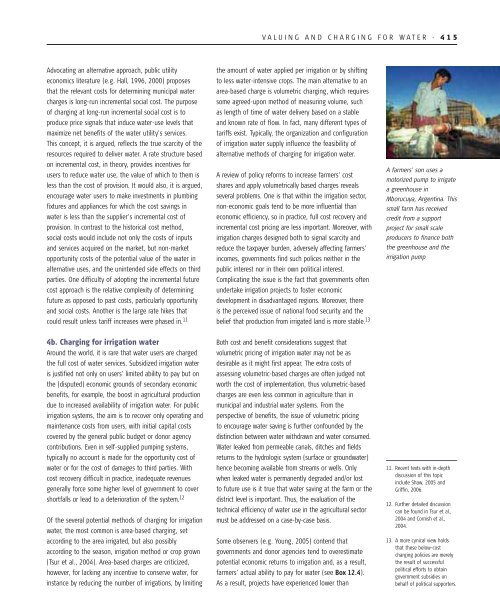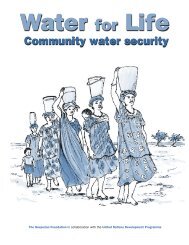Water: a shared responsibility; 2006 - UN-Water
Water: a shared responsibility; 2006 - UN-Water
Water: a shared responsibility; 2006 - UN-Water
Create successful ePaper yourself
Turn your PDF publications into a flip-book with our unique Google optimized e-Paper software.
V A L U I N G A N D C H A R G I N G F O R W A T E R . 415<br />
Advocating an alternative approach, public utility<br />
economics literature (e.g. Hall, 1996, 2000) proposes<br />
that the relevant costs for determining municipal water<br />
charges is long-run incremental social cost. The purpose<br />
of charging at long-run incremental social cost is to<br />
produce price signals that induce water-use levels that<br />
maximize net benefits of the water utility’s services.<br />
This concept, it is argued, reflects the true scarcity of the<br />
resources required to deliver water. A rate structure based<br />
on incremental cost, in theory, provides incentives for<br />
users to reduce water use, the value of which to them is<br />
less than the cost of provision. It would also, it is argued,<br />
encourage water users to make investments in plumbing<br />
fixtures and appliances for which the cost savings in<br />
water is less than the supplier’s incremental cost of<br />
provision. In contrast to the historical cost method,<br />
social costs would include not only the costs of inputs<br />
and services acquired on the market, but non-market<br />
opportunity costs of the potential value of the water in<br />
alternative uses, and the unintended side effects on third<br />
parties. One difficulty of adopting the incremental future<br />
cost approach is the relative complexity of determining<br />
future as opposed to past costs, particularly opportunity<br />
and social costs. Another is the large rate hikes that<br />
could result unless tariff increases were phased in. 11<br />
the amount of water applied per irrigation or by shifting<br />
to less water-intensive crops. The main alternative to an<br />
area-based charge is volumetric charging, which requires<br />
some agreed-upon method of measuring volume, such<br />
as length of time of water delivery based on a stable<br />
and known rate of flow. In fact, many different types of<br />
tariffs exist. Typically, the organization and configuration<br />
of irrigation water supply influence the feasibility of<br />
alternative methods of charging for irrigation water.<br />
A review of policy reforms to increase farmers’ cost<br />
shares and apply volumetrically based charges reveals<br />
several problems. One is that within the irrigation sector,<br />
non-economic goals tend to be more influential than<br />
economic efficiency, so in practice, full cost recovery and<br />
incremental cost pricing are less important. Moreover, with<br />
irrigation charges designed both to signal scarcity and<br />
reduce the taxpayer burden, adversely affecting farmers’<br />
incomes, governments find such polices neither in the<br />
public interest nor in their own political interest.<br />
Complicating the issue is the fact that governments often<br />
undertake irrigation projects to foster economic<br />
development in disadvantaged regions. Moreover, there<br />
is the perceived issue of national food security and the<br />
belief that production from irrigated land is more stable. 13<br />
A farmers' son uses a<br />
motorized pump to irrigate<br />
a greenhouse in<br />
Mborucuya, Argentina. This<br />
small farm has received<br />
credit from a support<br />
project for small scale<br />
producers to finance both<br />
the greenhouse and the<br />
irrigation pump<br />
4b. Charging for irrigation water<br />
Around the world, it is rare that water users are charged<br />
the full cost of water services. Subsidized irrigation water<br />
is justified not only on users’ limited ability to pay but on<br />
the (disputed) economic grounds of secondary economic<br />
benefits, for example, the boost in agricultural production<br />
due to increased availability of irrigation water. For public<br />
irrigation systems, the aim is to recover only operating and<br />
maintenance costs from users, with initial capital costs<br />
covered by the general public budget or donor agency<br />
contributions. Even in self-supplied pumping systems,<br />
typically no account is made for the opportunity cost of<br />
water or for the cost of damages to third parties. With<br />
cost recovery difficult in practice, inadequate revenues<br />
generally force some higher level of government to cover<br />
shortfalls or lead to a deterioration of the system. 12<br />
Of the several potential methods of charging for irrigation<br />
water, the most common is area-based charging, set<br />
according to the area irrigated, but also possibly<br />
according to the season, irrigation method or crop grown<br />
(Tsur et al., 2004). Area-based charges are criticized,<br />
however, for lacking any incentive to conserve water, for<br />
instance by reducing the number of irrigations, by limiting<br />
Both cost and benefit considerations suggest that<br />
volumetric pricing of irrigation water may not be as<br />
desirable as it might first appear. The extra costs of<br />
assessing volumetric-based charges are often judged not<br />
worth the cost of implementation, thus volumetric-based<br />
charges are even less common in agriculture than in<br />
municipal and industrial water systems. From the<br />
perspective of benefits, the issue of volumetric pricing<br />
to encourage water saving is further confounded by the<br />
distinction between water withdrawn and water consumed.<br />
<strong>Water</strong> leaked from permeable canals, ditches and fields<br />
returns to the hydrologic system (surface or groundwater)<br />
hence becoming available from streams or wells. Only<br />
when leaked water is permanently degraded and/or lost<br />
to future use is it true that water saving at the farm or the<br />
district level is important. Thus, the evaluation of the<br />
technical efficiency of water use in the agricultural sector<br />
must be addressed on a case-by-case basis.<br />
Some observers (e.g. Young, 2005) contend that<br />
governments and donor agencies tend to overestimate<br />
potential economic returns to irrigation and, as a result,<br />
farmers’ actual ability to pay for water (see Box 12.4).<br />
As a result, projects have experienced lower than<br />
11. Recent texts with in-depth<br />
discussion of this topic<br />
include Shaw, 2005 and<br />
Griffin, <strong>2006</strong>.<br />
12. Further detailed discussion<br />
can be found in Tsur et al.,<br />
2004 and Cornish et al.,<br />
2004.<br />
13. A more cynical view holds<br />
that these below-cost<br />
charging policies are merely<br />
the result of successful<br />
political efforts to obtain<br />
government subsidies on<br />
behalf of political supporters.
















